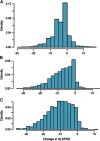How common are ALS plateaus and reversals?
- PMID: 26658909
- PMCID: PMC4793781
- DOI: 10.1212/WNL.0000000000002251
How common are ALS plateaus and reversals?
Abstract
Objective: To determine the frequency of amyotrophic lateral sclerosis (ALS) plateaus and reversals in the Pooled Resource Open-Access ALS Clinical Trials (PRO-ACT) database.
Methods: We analyzed Amyotrophic Lateral Sclerosis Functional Rating Scale (ALSFRS) and ALSFRS-revised (ALSFRS-R) data from PRO-ACT participants. The frequencies of participants experiencing plateaus (periods where scores did not change) were calculated over 6-, 12-, and 18-month epochs. The percentage of participants ever experiencing reversals (periods where scores improved) of different lengths were also calculated and plotted.
Results: Over 6 months, 25% of 3,132 participants did not decline. Over 12 months, 16% of 2,105 participants did not decline. Over 18 months, 7% of 1,218 participants did not decline. Small ALS reversals were also common, especially over shorter follow-up intervals; 14% of 1,343 participants had a 180-day interval where their ALSFRS-R slope was greater than zero. Fewer than 1% of participants ever experienced improvements of 4 or more ALSFRS-R points lasting at least 12 months.
Conclusion: ALS plateaus and small reversals are common, especially over brief intervals. In light of these data, stable disease, especially for a short period of time, should not be interpreted as an ALS treatment effect. Large sustained ALS reversals, on the other hand, are rare, potentially important, and warrant further study.
© 2015 American Academy of Neurology.
Figures


Comment in
-
Comment: Plateaus and reversals in ALS disease course or limitations of trial design?Neurology. 2016 Mar 1;86(9):811. doi: 10.1212/WNL.0000000000002365. Epub 2016 Jan 22. Neurology. 2016. PMID: 26802092 No abstract available.
References
-
- Tucker T, Layzer R, Miller R, Chad D. Subacute reversible motor neuron disease. Neurology 1991;41:1541–1544. - PubMed
-
- Immunosuppression in Amyotrophic Lateral Sclerosis (ALS) (NIPALS2013). Available at: https://clinicaltrials.gov/ct2/show/NCT01884571?term=als+immunosuppressi.... Accessed May 6, 2015.
-
- Cedarbaum J, Stambler N. Performance of the Amyotrophic Lateral Sclerosis Functional Rating Scale (ALSFRS) in multicenter clinical trials. J Neurol Sci 1997;152:S1–S9. - PubMed
-
- Cedarbaum J, Stambler N, Malta E, et al. The ALSFRS-R: a revised ALS functional rating scale that incorporates assessments of respiratory function. J Neurol Sci 1999;169:13–21. - PubMed
Publication types
MeSH terms
LinkOut - more resources
Full Text Sources
Medical
Molecular Biology Databases
Miscellaneous
